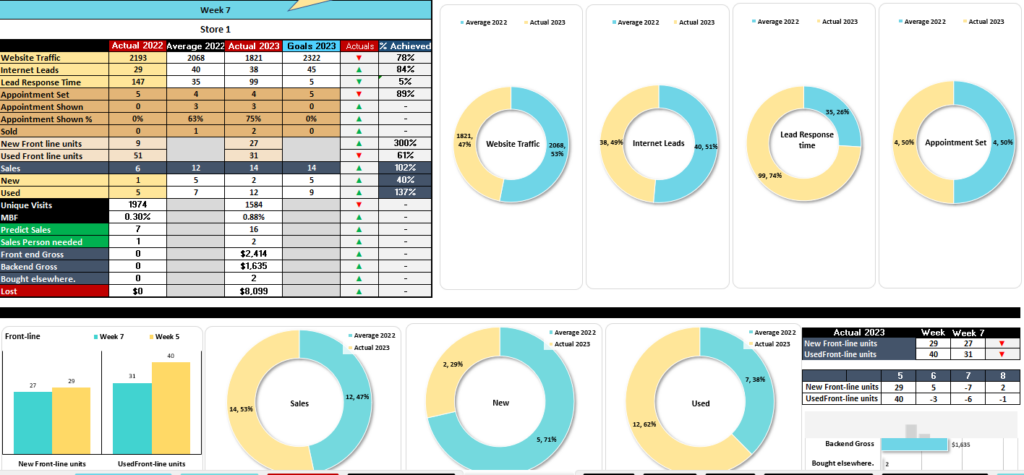Attribution is one of the most frustrating and often uncomfortable conversations for any marketing director or vendor partner.
- How do we measure digital efforts?
- How do we measure such efforts in a visually consumable format?
These types of questions are difficult and time-consuming to answer. Yet, who can blame the need to know what your dealership is getting compared to your spending? In my career, I have worked with all levels of stores, from small independents to large-scale groups and among all of them. The one consistent marketing desire is how to figure out the best way to attribute digital spending.
Leads Aren’t as Great as You Think
It is essential to remember that leads are not the only indicator of success in automotive digital marketing. In-market traffic is a valuable metric to track, as it indicates the number of potential customers actively searching for products or services like yours. There are a lot of metrics to be considered, such as engagement, click-through, and conversion rates. These can provide valuable insights into your digital marketing efforts.
Additionally, it is important to consider the quality of your leads rather than just the quantity. Tracking various metrics and using them to inform your overall automotive digital marketing strategy is more important than relying solely on leads or any other metric.

Leads may be an easy way to measure performance they are not—nor should they be used as—the indicator of success in digital marketing. Why? They only make up 29% of your website traffic. Lead conversion is too low of a baseline for conversion metrics.
Not All Digital Traffic Is Created Equal
Not all traffic is created equal, and not all traffic is lead-generating. Here at DTVMS, we believe in-market traffic to be a more accurate gauge. The more people you have in your digital dealership, the more chances to sell—whether they submit a lead or not.
Recently we heard that the number of dealerships a customer goes to has not decreased. They just go to those dealerships online instead. It is the number of brick-and-mortar dealership visits that has reduced.
Automotive digital marketing is your virtual lot, showroom, and opportunity to attract customers to your brick-and-mortar. They don’t need to submit a lead to walk into your building, and they aren’t.
However, that virtual experience needs to be on point. Here are some areas to focus on:
SEM–Search Engine Marketing
Your SEM, 3rd party efforts, landing pages, and the like must be strong enough to convince your potential customer off their couch and into a test drive. Attaching these efforts to incentives—specific sales, dealership events, etc.—will capture more consumer intent.
Social Media
Social media continues to be the most cost effective way to drive people to your website but remember the user isn’t going to social media to look for cars they are going for entertainment or education. The best way to convert this type of customer is to interrupt their experience with a motivating hook, bring them to a landing page, filter out their interests, and potentially convert them into a lead.
Retargeting Campaigns
Based on people visiting your website, retargeting assumes the consumer is already in some stage of the buying process. Marketing spent on retargeting is designed to stay present and top of mind for the shoppers who may be taking a little longer to decide.

Another contributing factor that correlates to digital traffic is how many available front-line units you have ready to sell. Often times decision makers are so focused on activity levels without taking into consideration the amount of vehicles they have available for sale. Knowing what the weekly count of your front line units is, and how many you are dripping in relationship to how many you sell, is probably one of the most overlooked elements of activity generation.
For example, a weekly drip that is less than your sales has a negative impact on activity because people buy in 60-90 day cycles and if you have less inventory available you have less opportunity to catch intent. If your drip is over what you are selling, then you will have a surplus of opportunities, but you will run the risk of having aged inventory in the future. Understanding the relationship between inventory and digital activity is one of the quickest ways to predict and anticipate sold units.
Once I Know What Metrics To Use, Then What?
After spending time researching and implementing these strategies, the question becomes the aforementioned frustration– how do you measure what is working and what is not working? There are three things to consider: performance, cost, and spending. Let’s not kid ourselves, the only way to effectively measure digital activity is through impressions, clicks/views, and leads. Vendors may provide one, or a combination of these metrics and typically it is these combinations that give you the complete picture.
Autotrader and cars.com, for example, drive impressions and views—they do so on their platforms and not your website. That still has value; people saw your inventory. A lead can be created.
AIA ads and Google search ads drive impressions and views to your website. These impressions on their platform drive clicks to your sandbox, where you have control. Based on how your website is set up, you can turn these clicks into leads via calls-to-action (CTA) on your site.
Every digital initiative drives impressions, leads, views, or a combination of the three. So why do we complicate it? It’s simple: you should track these things on a monthly basis. You should know what each vendor represents and how much their impressions, views/clicks, and leads are worth. Then, by accurately connecting to your CRM, you will be able to draw a direct correlation and begin to fully understand your Cost Per Sale (CPS).
Impact On Marketing
We have often talked about the impact of driving people to your website instead of investing in efforts that keep your customer on another platform.
Keeping your customer in your sandbox–the land of no competitors–is key.
Just as you pick a prime location for your physical dealership, you must do the same for your digital dealership. The more chances you have of capturing digital ups, the more chances you have of selling a car.
If your activity is down, add more to the provider offering the best ROI for what you are trying to accomplish. Understanding the value of each metric of performance is paramount–that way, if you are trying to generate more traffic, you know where to go, and if you are trying to generate more leads, you also know where to go.
Capturing Intent
Driving traffic to your website is one thing, but setting up to handle that traffic is another. From time on site to response time to time to the box every moment matters and every moment has a price-tag. This year, advertising costs will increase, and dealerships will need to invest more money into digital marketing to Unlike in 2008 and 2009, we don’t have low demand with inventory surplus but rather high demand with inventory shortages. Quickly and accurately capturing the intent of customers that waited out the last two years before transacting will be the difference between having a good year and a not-so-good year. Rates and consumer confidence will impact traffic, and we must be ready. Knowing your numbers is the first step.

As decision-makers, we should pay attention to impressions, clicks/views, leads, and the cost of selling a vehicle, which should be around $350. As new inventory increases, this will obviously adjust, but $350 CPS is the sweet spot for the industry currently.
Your Homework
Here’s a test for you: ask your marketing director or vendor partners if they know what your average cost per sale, cost per lead, cost per view/click, and cost per impression is. If they don’t, or if you don’t know the answer, then you are measuring your automotive digital marketing efforts based on hope and prayer, not factual information. You need to know those numbers to measure your digital efforts effectively. Leads are just a tiny fraction of the equation, and the other factors are more important. Remember, most of the traffic isn’t converting to a lead anyway. Focusing on leads is focusing on the lowest possible ROI, which is unfair to you, your sales staff, or your vendors.

If you don’t know, you need to start with a plan to measure these things regularly for all your vendors. A spreadsheet is a great place to start. Take some time to list your vendors and begin tracking the above information to start to average it.
If you need help, you can reach me here.
Herb Anderson/Charity Ann




